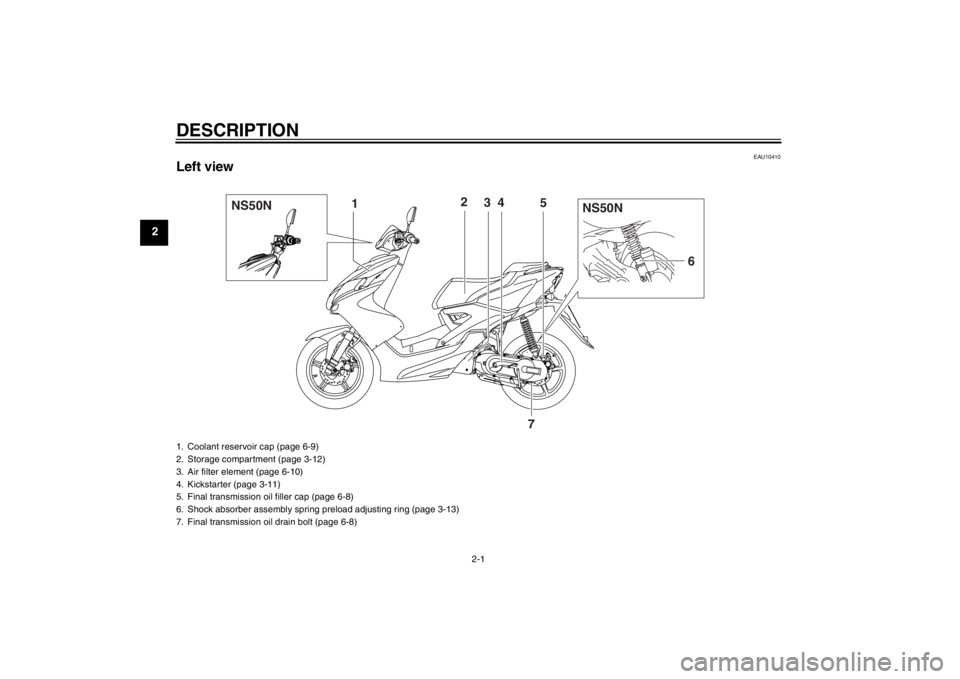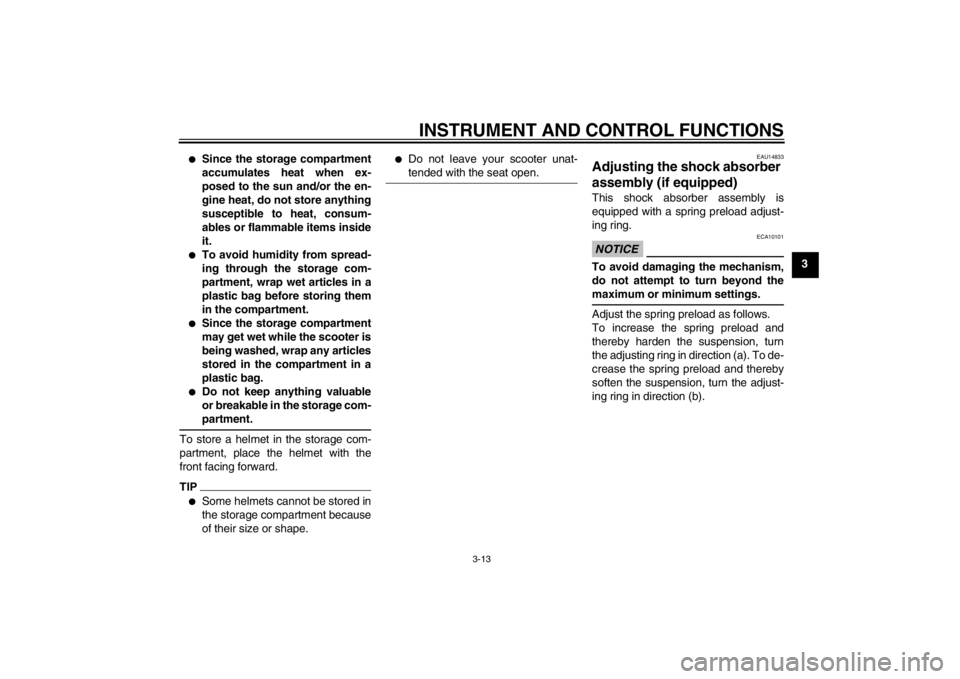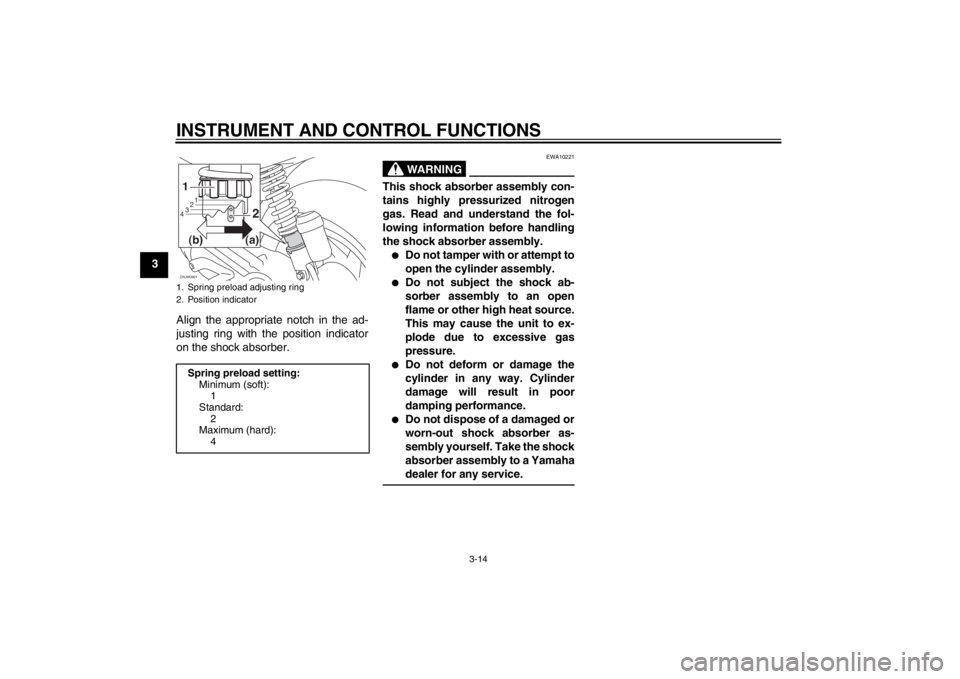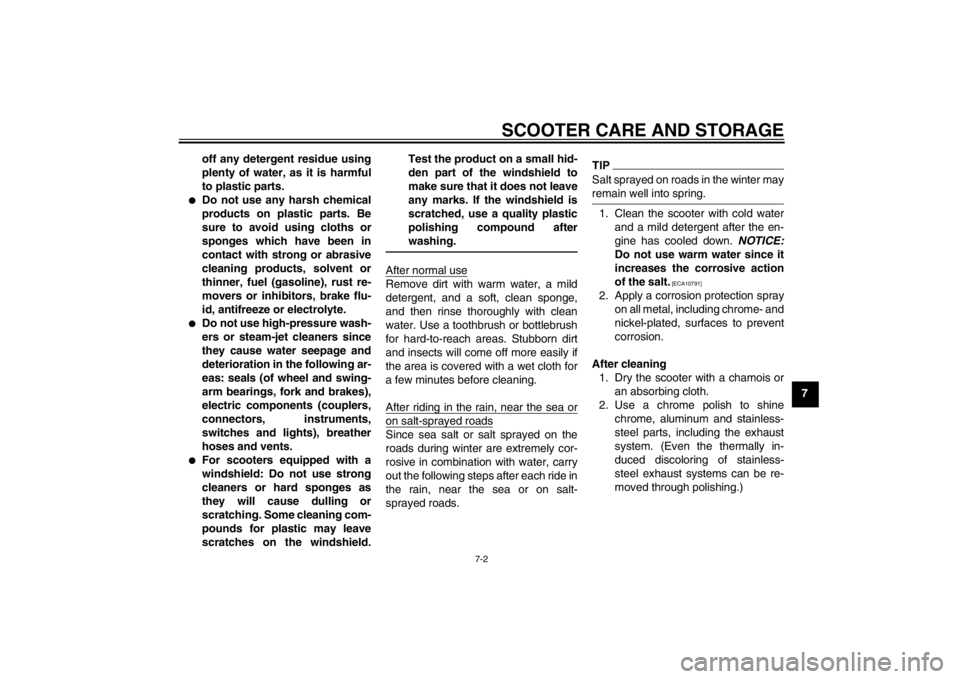2013 YAMAHA AEROX50 ABS
[x] Cancel search: ABSPage 6 of 74

TABLE OF CONTENTSSAFETY INFORMATION ..................1-1
Further safe-riding points ................1-5
DESCRIPTION ..................................2-1
Left view ..........................................2-1
Right view ........................................2-2
Controls and instruments.................2-3
INSTRUMENT AND CONTROL
FUNCTIONS.......................................3-1
Main switch/steering lock ................3-1
Indicator lights and warning light ....3-2
Speedometer unit (NS50N) .............3-3
Multi-function display (NS50)...........3-4
Handlebar switches ........................3-6
Front brake lever ............................3-7
Rear brake lever .............................3-7
Fuel and 2-stroke engine oil tank
caps .............................................3-8
Fuel .................................................3-9
Catalytic converter ........................3-10
2-stroke engine oil ........................3-10
Kickstarter .....................................3-11
Seats ............................................3-11
Storage compartment ...................3-12
Adjusting the shock absorber
assembly (if equipped) ...............3-13FOR YOUR SAFETY –
PRE-OPERATION CHECKS............. 4-1
OPERATION AND IMPORTANT
RIDING POINTS................................. 5-1
Starting a cold engine .................... 5-1
Starting off ...................................... 5-2
Acceleration and deceleration ........ 5-2
Braking ........................................... 5-2
Tips for reducing fuel
consumption ............................... 5-3
Engine break-in .............................. 5-3
Parking ........................................... 5-4
PERIODIC MAINTENANCE AND
ADJUSTMENT................................... 6-1
Periodic maintenance chart for
the emission control system ....... 6-2
General maintenance and
lubrication chart .......................... 6-3
Removing and installing the cowling
and panel .................................... 6-6
Checking the spark plug ................. 6-7
Final transmission oil ...................... 6-8
Coolant ........................................... 6-9
Cleaning the air filter element ...... 6-10
Adjusting the carburetor ............... 6-11
Checking the throttle grip free
play ........................................... 6-11
Tires ............................................. 6-12
Cast wheels .................................. 6-14Checking the front and rear brake
lever free play ........................... 6-14
Checking the front and rear brake
pads .......................................... 6-15
Checking the brake fluid level ...... 6-15
Changing the brake fluid .............. 6-16
Checking and lubricating
the throttle grip and cable ......... 6-17
Lubricating the front and rear
brake levers .............................. 6-17
Checking and lubricating the
centerstand ............................... 6-17
Checking the front fork ................. 6-18
Checking the steering .................. 6-19
Checking the wheel bearings ....... 6-19
Battery ......................................... 6-19
Replacing the fuse ....................... 6-21
Replacing the headlight bulb ....... 6-22
Replacing the tail/brake light
bulb ........................................... 6-23
Replacing a turn signal light
bulb ........................................... 6-23
License plate light ........................ 6-24
Replacing the auxiliary light bulb
(if equipped) .............................. 6-24
Troubleshooting ........................... 6-25
Troubleshooting charts ................ 6-26
SCOOTER CARE AND STORAGE... 7-1
Matte color caution ........................ 7-1
Care ............................................... 7-1U1PHE0E0.book Page 1 Wednesday, August 29, 2012 4:42 PM
Page 14 of 74

DESCRIPTION
2-1
2
EAU10410
Left view
NS50N
NS50N
12
34
5
6
7
1. Coolant reservoir cap (page 6-9)
2. Storage compartment (page 3-12)
3. Air filter element (page 6-10)
4. Kickstarter (page 3-11)
5. Final transmission oil filler cap (page 6-8)
6. Shock absorber assembly spring preload adjusting ring (page 3-13)
7. Final transmission oil drain bolt (page 6-8)U1PHE0E0.book Page 1 Wednesday, August 29, 2012 4:42 PM
Page 29 of 74

INSTRUMENT AND CONTROL FUNCTIONS
3-13
3
●
Since the storage compartment
accumulates heat when ex-
posed to the sun and/or the en-
gine heat, do not store anything
susceptible to heat, consum-
ables or flammable items inside
it.
●
To avoid humidity from spread-
ing through the storage com-
partment, wrap wet articles in a
plastic bag before storing them
in the compartment.
●
Since the storage compartment
may get wet while the scooter is
being washed, wrap any articles
stored in the compartment in a
plastic bag.
●
Do not keep anything valuable
or breakable in the storage com-
partment.
To store a helmet in the storage com-
partment, place the helmet with the
front facing forward.TIP●
Some helmets cannot be stored in
the storage compartment because
of their size or shape.
●
Do not leave your scooter unat-
tended with the seat open.
EAU14833
Adjusting the shock absorber
assembly (if equipped)This shock absorber assembly is
equipped with a spring preload adjust-
ing ring.NOTICE
ECA10101
To avoid damaging the mechanism,
do not attempt to turn beyond the
maximum or minimum settings.Adjust the spring preload as follows.
To increase the spring preload and
thereby harden the suspension, turn
the adjusting ring in direction (a). To de-
crease the spring preload and thereby
soften the suspension, turn the adjust-
ing ring in direction (b).
U1PHE0E0.book Page 13 Wednesday, August 29, 2012 4:42 PM
Page 30 of 74

INSTRUMENT AND CONTROL FUNCTIONS
3-14
3Align the appropriate notch in the ad-
justing ring with the position indicator
on the shock absorber.
WARNING
EWA10221
This shock absorber assembly con-
tains highly pressurized nitrogen
gas. Read and understand the fol-
lowing information before handling
the shock absorber assembly.●
Do not tamper with or attempt to
open the cylinder assembly.
●
Do not subject the shock ab-
sorber assembly to an open
flame or other high heat source.
This may cause the unit to ex-
plode due to excessive gas
pressure.
●
Do not deform or damage the
cylinder in any way. Cylinder
damage will result in poor
damping performance.
●
Do not dispose of a damaged or
worn-out shock absorber as-
sembly yourself. Take the shock
absorber assembly to a Yamaha
dealer for any service.
1. Spring preload adjusting ring
2. Position indicatorSpring preload setting:Minimum (soft):1
Standard:
2
Maximum (hard): 4(b) (a)1ZAUM0961
1
2
3
4
2
U1PHE0E0.book Page 14 Thursday, September 6, 2012 3:30 PM
Page 40 of 74

PERIODIC MAINTENANCE AND ADJUSTMENT
6-4
6
9*Wheel bearings • Check bearing for looseness or
damage. √√√√
10 *Steering bearings Check bearing play and steering
for roughness. √√√√√
Lubricate with lithium-soap-based grease. Every 24000 km (14000 mi)
11 *Chassis fasteners Make sure that all nuts, bolts and
screws are properly tightened. √√√√√
12 Front brake lever
pivot shaft
Lubricate with silicone grease.
√√√√√
13 Rear brake lever
pivot shaft Lubricate with silicone grease.
√√√√√
14 Centerstand Check operation.
Lubricate. √√√√√
15 *Front fork Check operation and for oil leak-
age. √√√√
16 *Shock absorber as-
sembly Check operation and shock ab-
sorber for oil leakage. √√√√
17 *Autolube pump Check operation.
Bleed if necessary. √√√√
18 *Cooling system Check coolant level and vehicle
for coolant leakage. √√√√√
Change coolant. Every 3 years
19 Final transmission
oil Check vehicle for oil leakage.
√√ √
Change. √√√
20 *V- b e l t Replace. Every 10000 km (6000 mi)
NO. ITEM CHECK OR MAINTENANCE JOB
ODOMETER READING
ANNUAL
CHECK
1000 km
(600 mi) 6000 km
(3500 mi) 12000 km
(7000 mi) 18000 km
(10500 mi) 24000 km
(14000 mi)
U1PHE0E0.book Page 4 Thursday, February 21, 2013 2:56 PM
Page 65 of 74

SCOOTER CARE AND STORAGE
7-2
7 off any detergent residue using
plenty of water, as it is harmful
to plastic parts.
●
Do not use any harsh chemical
products on plastic parts. Be
sure to avoid using cloths or
sponges which have been in
contact with strong or abrasive
cleaning products, solvent or
thinner, fuel (gasoline), rust re-
movers or inhibitors, brake flu-
id, antifreeze or electrolyte.
●
Do not use high-pressure wash-
ers or steam-jet cleaners since
they cause water seepage and
deterioration in the following ar-
eas: seals (of wheel and swing-
arm bearings, fork and brakes),
electric components (couplers,
connectors, instruments,
switches and lights), breather
hoses and vents.
●
For scooters equipped with a
windshield: Do not use strong
cleaners or hard sponges as
they will cause dulling or
scratching. Some cleaning com-
pounds for plastic may leave
scratches on the windshield.Test the product on a small hid-
den part of the windshield to
make sure that it does not leave
any marks. If the windshield is
scratched, use a quality plastic
polishing compound after
washing.
After normal useRemove dirt with warm water, a mild
detergent, and a soft, clean sponge,
and then rinse thoroughly with clean
water. Use a toothbrush or bottlebrush
for hard-to-reach areas. Stubborn dirt
and insects will come off more easily if
the area is covered with a wet cloth for
a few minutes before cleaning.
After riding in the rain, near the sea oron salt-sprayed roadsSince sea salt or salt sprayed on the
roads during winter are extremely cor-
rosive in combination with water, carry
out the following steps after each ride in
the rain, near the sea or on salt-
sprayed roads.
TIPSalt sprayed on roads in the winter may
remain well into spring.1. Clean the scooter with cold water
and a mild detergent after the en-
gine has cooled down. NOTICE:
Do not use warm water since it
increases the corrosive action
of the salt.
[ECA10791]
2. Apply a corrosion protection spray
on all metal, including chrome- and
nickel-plated, surfaces to prevent
corrosion.
After cleaning
1. Dry the scooter with a chamois or
an absorbing cloth.
2. Use a chrome polish to shine
chrome, aluminum and stainless-
steel parts, including the exhaust
system. (Even the thermally in-
duced discoloring of stainless-
steel exhaust systems can be re-
moved through polishing.)
U1PHE0E0.book Page 2 Wednesday, August 29, 2012 4:42 PM
Page 69 of 74

SPECIFICATIONS
8-2
8
Manufacturer/model:
SAVA/ MC 16
Manufacturer/model:
METZELER/ ME 7 TEENRear tire:Type:
Tubeless
Size:
140/60-13 57P(Michelin)
57L(SAVA,Metzeler)
Manufacturer/model:
MICHELIN/POWER PURE SC
Manufacturer/model:
SAVA/ MC 16
Manufacturer/model:
METZELER/ ME 7 TEENLoading:Maximum load:
185 kg (408 lb)
(Total weight of rider, passenger, cargo and
accessories)Tire air pressure (measured on cold
tires):Loading condition:
0–90 kg (0–198 lb)
Front:
180 kPa (1.80 kgf/cm², 26 psi)
Rear:
200 kPa (2.00 kgf/cm², 29 psi)
Loading condition:
90–185 kg (198–408 lb)
Front:
190 kPa (1.90 kgf/cm², 28 psi)Rear:
220 kPa (2.20 kgf/cm², 32 psi)
Front wheel:Wheel type:
Cast wheel
Rim size:
13xMT3.00Rear wheel:Wheel type:
Cast wheel
Rim size:
13xMT3.50Front brake:Type:
Single disc brake
Operation:
Right hand operation
Specified brake fluid:
DOT 4Rear brake:Type:
Single disc brake
Operation:
Left hand operation
Specified brake fluid:
DOT 4Front suspension:Type:
Telescopic fork
Spring/shock absorber type:
Coil spring/oil damper
Wheel travel:
80.0 mm (3.15 in)
Rear suspension:Type:
Unit swing
Spring/shock absorber type:
Coil spring/oil damper
Wheel travel:
70.0 mm (2.76 in)Electrical system:Ignition system:
DC CDI
Charging system:
AC magnetoBattery:Model:
CB4-LB(GS)
Voltage, capacity:
12 V, 4.0 AhHeadlight:Bulb type:
IncandescenceBulb voltage, wattage × quantity:Headlight:
12 V, 35.0 W/35.0 W × 1
Tail/brake light:
12 V, 21.0 W/5.0 W × 1
Front turn signal light:
12 V, 10.0 W × 2
Rear turn signal light:
12 V, 10.0 W × 2
Auxiliary light:
12 V, 5.0 W × 2
Meter lighting:
LED
U1PHE0E0.book Page 2 Wednesday, August 29, 2012 4:42 PM
Page 72 of 74

INDEX22-stroke engine oil................................. 3-10AAcceleration and deceleration................. 5-2
Air filter element, cleaning..................... 6-10
Auxiliary light bulb, replacing
(if equipped)........................................ 6-24BBattery................................................... 6-19
Brake fluid, changing ............................ 6-16
Brake fluid level, checking .................... 6-15
Brake lever, front..................................... 3-7
Brake lever, rear ..................................... 3-7
Brake levers, lubricating........................ 6-17
Braking .................................................... 5-2CCarburetor,adjusting ............................. 6-11
Care ........................................................ 7-1
Catalytic converter ................................ 3-10
Centerstand, checking and
lubricating ........................................... 6-17
Coolant.................................................... 6-9
Coolant temperature warning light .......... 3-3
Cowling and panel, removing and
installing................................................ 6-6DDimmer switch ........................................ 3-7EEngine break-in ....................................... 5-3FFinal transmission oil .............................. 6-8
Front and rear brake lever free play,
checking ............................................. 6-14
Front and rear brake pads, checking .... 6-15Front fork, checking .............................. 6-18
Fuel......................................................... 3-9
Fuel and 2-stroke engine oil tank caps ... 3-8
Fuel consumption, tips for reducing........ 5-3
Fuel level warning light ........................... 3-3
Fuse, replacing ..................................... 6-21
HHandlebar switches ................................ 3-6
Headlight bulb, replacing ...................... 6-22
High beam indicator light ........................ 3-2
Horn switch ............................................. 3-7IIdentification numbers ............................ 9-1
Indicator lights and warning light ............ 3-2KKickstarter............................................. 3-11LLicense plate light ................................. 6-24MMain switch/steering lock........................ 3-1
Maintenance and lubrication, periodic .... 6-3
Maintenance, emission control
system .................................................. 6-2
Matte color, caution ................................ 7-1
Model label ............................................. 9-1
Multi-function display (NS50).................. 3-4OOil level warning light.............................. 3-2PParking ................................................... 5-4
Part locations .......................................... 2-1SSafe-riding points.................................... 1-5
Safety information................................... 1-1Seats ..................................................... 3-11
Shock absorber assembly,
adjusting (if equipped) ........................ 3-13
Spark plug, checking ............................... 6-7
Specifications .......................................... 8-1
Speedometer unit (NS50N) ..................... 3-3
Starting a cold engine ............................. 5-1
Starting off ............................................... 5-2
Start switch.............................................. 3-7
Steering, checking................................. 6-19
Storage.................................................... 7-3
Storage compartment............................ 3-12
TTail/brake light bulb, replacing .............. 6-23
Throttle grip and cable, checking and
lubricating ........................................... 6-17
Throttle grip free play, checking ............ 6-11
Tires ...................................................... 6-12
Troubleshooting .................................... 6-25
Troubleshooting charts.......................... 6-26
Turn signal indicator light ........................ 3-2
Turn signal light bulb, replacing ............ 6-23
Turn signal switch ................................... 3-7VVehicle identification number .................. 9-1WWheel bearings, checking ..................... 6-19
Wheels .................................................. 6-14
U1PHE0E0.book Page 1 Wednesday, August 29, 2012 4:42 PM